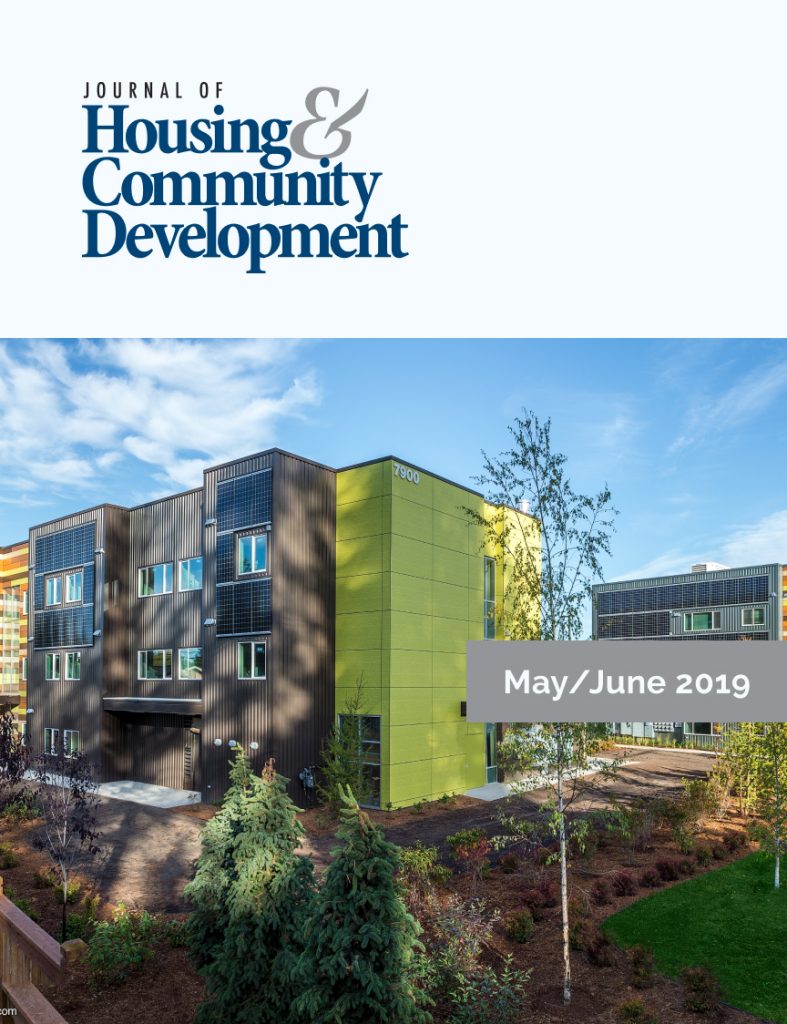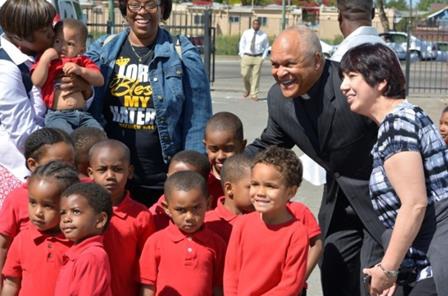Low-Investment, High-Impact Strategies to Boost Education Outcomes

More than 1.7 million children from birth to age eight are living in public and assisted housing in the United States. Research shows that eighty percent of children from low-income families enter kindergarten so far behind that they do not catch up and are unable to read proficiently by the end of third grade, a key predictor of high school graduation.
Failure to graduate from high school erodes a child’s options for economic opportunity and costs society immensely. The US Census Bureau reports that high school graduates will earn over $850,000 more in their lifetime compared to high school dropouts. Further, the average high school dropout consumes more than 20 times the amount of public health insurance as a college graduate.[1]
However, we can help change that trajectory. Housing can be a critical platform and portal for early learning, sustained school success, and economic wellbeing.
There’s a growing body of evidence that positively links affordable, stable, and quality housing with improved educational outcomes for children. That research continually points to the positive return on investment for the earliest possible intervention. Housing authorities are uniquely poised to help change the trajectory for low-income children who typically arrive in kindergarten already substantially behind their peers. We can leverage unique assets that other systems players cannot.
One argument about why the housing sector – and the entire community – needs to support public schooling is both structural and mathematical. Public school engages children at a point in the learning process (kindergarten or even first grade in some states) when, often, it’s too late. A child’s brain is nearly fully formed by age 5 when kindergarten begins. Early brain development sets the stage for a child’s ability to learn and succeed, both in school and later in life. According to First Things First[2], “From birth to age 5, a child’s brain develops more than at any other time in life.” More importantly, “[t]he quality of a child’s experiences in the first few years of life – positive or negative – helps shape how their brain develops.” Compelling new research tells us that poverty, and adverse childhood experiences, compound the problem and act like poison on a child’s brain.[3]
And further compounding the “late start”, the public school’s contact time with children is woefully inadequate for many low-income and/or minority families. The waking hours in a child’s life that are not school-centric – those hours before school, after-school, evenings, weekends, holidays, teacher training days and summers – equal 83% of waking life during grades 1 through 12. In other words, if children are in school only 17% of their waking time, then public schooling is, by default, heavily dependent on school continuing at home.

As housing organizations, school continuing at home can mean us. We can enrich the broader campus called home and decide what to do with these assets to be a partner in closing achievement, equity and opportunity gaps.
Regarding our systems, we can think all the way through the resident interaction chain – from application/admissions to notice to vacate – and find an effective strategy at each step of our process.
Marketing
- Name your program, even if it’s a small program.
In fact, a big name can signal a big ambition. Naming your program tells your prospective and current residents about your intention to be part of the solution that supports parents and kids. It tells future applicants what kind of environment you want to create at your properties.
One of the best programs to come out of HUD, though it never got off the ground, was the Campus of Learners program, if for no other reason than the name evoked a clear mission and sense of purpose. Examples – Compass to College (Austin); Elm City Believes (New Haven); Building for Tomorrow (Akron), and Talk-Read-Succeed (Springfield).
Admissions
- In your application for housing assistance, ask where children attend school.
This information will help your program planning and could be a reminder to parents that changing schools can harm a normal child and adolescent development by disrupting relationships with peers and teachers as well as altering a student’s educational program. The most consistent and severe impacts are on test scores and high school graduation. The gravest harms follow from multiple moves and those accompanied by disruptions in the home.[i]
You can even take this a step further and provide the context: “We’d like to help you keep your child in their neighborhood school or preschool program. Where are they currently enrolled?”
- Make a library card application part of your housing application.
You can make your public library a more welcoming place for your residents if you work with your local library to make their application part of yours. Many libraries are eliminating penalties and fees for late materials, thus eliminating one of the barriers to library participation.
- Create an early childhood admissions policy
At a time when public and assisted housing is an increasingly scarce resource, it might be a very difficult policy conversation in your community to propose targeting admission to families with young children. The research is so compelling, however, both about the critical role housing plays in educational outcomes and about the critical importance of intervening early, that aligning all of our social supports around families with young children makes a lot of sense.
Boulder Housing Partners was the first housing authority in the country to voluntarily adopt an age-based admissions preference. Every unit in BHP’s public housing portfolio at turnover goes to a family with a child under the age of six. After long conversations in the community, the proposal won support based on several factors: strong evidence of potential outcomes from early investment in parents and children; an equally strong program with a long track record of supporting young families; and a diverse range of other housing options for families with older children.
In a legal opinion prepared for Bringing School Home, Rod Solomon writes “…there is statutory and regulatory authorization to support a local preference in the public housing and Section 8 programs for families with children who can benefit from improved access to comprehensive pre-school or after-school activities that the local preference would make possible, provided that the expected benefits of the local preference are properly documented and procedural requirements for its adoption are followed.”
Move-in
- Arrange to leave age-appropriate books in the apartment for move-in day.
Sixty-one percent of low-income families have no age-appropriate books in their homes[ii]and other studies have found that most low-income neighborhoods are book deserts, with only one book for every 300 children.[iii]
You can imagine how impactful it would be to instead make it possible for one child to have access to 300 books on your campus. You could make this a project of one of your youth groups or service clubs. Free books abound; see below.
Property management and the residency tenure
- Create a book-rich environment
You can make your property rich with books simply by putting them everywhere children and their parents are: in laundry rooms, in common areas, in community rooms, in Little Free Libraries, in your property management office, in your maintenance vans, at your community meetings, at your HCV recertification meetings and anywhere else you can dream up.
As you think about whether you can manage this level of effort and investment, think about this: In spite of the fact that reading aloud is a simple way to provide rich exposure to language and strengthen school readiness, fewer than half (48%) of young children in the U.S. are read to daily. The percentage of children read to daily drops even lower (to 36%) among low-income families, whose children face the highest risk of literacy problems.[iv] If you can change the odds of a child being read to, your impact will be large.
HUD and DOE are two of the government partners, along with the National Book Foundation, in a program called Book Rich Environments (BRE). BRE is a tri-sector collaboration between nonprofit organizations, national government agencies, and corporate publishers that aims to infuse public housing communities across the country with a vibrant and accessible culture of books. Eight corporate publishers have committed books to the program. BRE is currently at its maximum capacity with 37 participating housing authorities, but there is a waiting list. Please add your name to that list so that HUD and DOE understand the demand.
In the meantime, Reading Rockets is a good website for getting started finding books.
- Modify your software to promote pre-school enrollment
Along with making books available to encourage more reading, one of the equally impactful things you can do is to help your parents enroll their child in preschool; the research about the value of quality preschool is incontrovertible. One way to do this easily is to add a feature to your housing software to alert you when a child turns two. At that point, your staff can begin talking to parents about preschool options in your community and the value of preschool. If everyone working in the housing sector did nothing more than create a book-rich environment and helped with preschool enrollment, we would make a big difference.
But, there’s so much more you can consider in a high-impact, low-cost framework:
- Connect with your public partners
- Your public library is a first point of connection in building a program. Many libraries bring their programs on site or sponsor book-mobiles and mobile classrooms. They sponsor summer reading and have vast educational programs. They share your mission to educate young children.
- Your public school is equally a first stop. They know what the gaps are, they know where their programs aren’t reaching children and can often identify where you can be helpful. If they don’t understand your role, quote the 17% statistic. You are the 83% partner.
- The public health department is often over-looked, but medical problems are one of the leading causes of absenteeism for public housing children. Get them to help you help your parents set up a medical home for their family.
- Find local partners
There are a number of national evidence-based programs that operate local programs:
- Nurse Family Partnership
- Parents As Teachers
- Home Instruction for Parents of Preschool Youngsters (HIPPY)
- Incredible Years
- Join the Campaign for Grade Level Reading: if your community is not currently a partner, be the energy behind getting your community to join.
- Ask how you can help with your community’s Cradle-to-Career continuum if there is one. If there isn’t what could you do to seed that effort?
- Modify lease terms
Children living in low-income households who move three or more times for negative reasons before they turn 18 are 15 percent less likely to complete high school, 36 percent less likely to enroll in college or another postsecondary education program by age 25, and 68 percent less likely to complete a four-year college degree by age 25 than poor children who never move.[4]
Research distinguishes between voluntary, or opportunistic moves, and involuntary. Many of the involuntary moves are related to housing challenges. Can we restructure family lease cycles so that leases end only in the summer months? Can we do something in our HCV programs to limit the number of moves that families pursue for small gains? PHAs can have a symbolic, if not significant, impact on mobility with a policy change that would have all of its housing leases end during the non-school, primarily summer, months.
There are dozens of other ideas and strategies that Bringing School Home has developed and/or catalogued to help housing providers leverage and evaluate their investment in education. This article is just the tip of the vast platform potential we have as affordable housers to deploy our policies and programs in service of closing the achievement, opportunity and equity gaps for our children and their families.
Authors:
Betsey Martens is the Founder and President of Bringing School Home, a consultancy that provides technical assistance to affordable housing providers to inspire and support them in becoming an active partner in closing the achievement gap for low-income and minority children.
Erica Plut is the lead researcher for Bringing School Home.
[1] Belfield, C.R. “The Price We Pay: Economic and Social Consequences of Inadequate Education.” Washington, D.C.: Brookings Institution, 2007.
[2] https://www.firstthingsfirst.org/early-childhood-matters/brain-development/
[3] Cookson, Clive, “Poverty Mars Formation of Infant Brain”, Financial Times, February 16, 2008
[4] Child Poverty and Adult Success, Urban Institute
[i] Rumberger, Russell June 2015 “Student Mobility: Causes, Consequences, and Solutions” National Education Policy Center, Boulder, CO
[ii] Reading Literacy in the United States: Findings from the IEA Reading Literacy Study, 1996
[iii] Neuman, S., & Dickinson, D. (Eds.). (2006) Handbook of Early Literacy Research (Vol. 2).
[iv] Reach Out and Read, Reading Across the Nation: A Chartbook, 2007
More Articles in this Issue
Award of Excellence: Phoenix Court Apartments
The Housing Authority of Northumberland County (HANC) wins a 2018 Award of Excellence in Community…Awards of Excellence: The Wimberly Center for Community Development
The Winder Housing Authority (WHA) wins a 2018 Award of Excellence in Community Revitalization for…Award of Excellence: Brainerd Oaks
The Crow Wing County Housing and Redevelopment Authority (CWC HRA) and the Brainerd Housing and…Commissioners as Advocates and Educators
We commissioners are in a unique and powerful position to advocate on behalf of our…The Disastrous State of Latino Housing (and How to Deal with It)
Where you live matters for how healthy you are. Sadly, U.S. Latino communities are marked…Awards of Excellence: Acts Cyrene Apartments
The Oakland Housing Authority (OHA) wins a 2018 Award of Excellence in Community Revitalization for…




